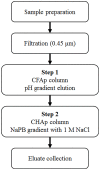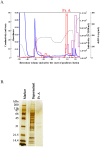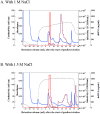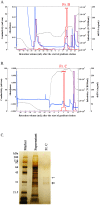Sequential two-step chromatographic purification of infectious poliovirus using ceramic fluoroapatite and ceramic hydroxyapatite columns
- PMID: 31536514
- PMCID: PMC6752803
- DOI: 10.1371/journal.pone.0222199
Sequential two-step chromatographic purification of infectious poliovirus using ceramic fluoroapatite and ceramic hydroxyapatite columns
Abstract
Infectious virus purification techniques are important for vaccine development and gene therapy applications. However, the standardized one-step purification technique using ceramic hydroxyapatite (CHAp) has proven unsuitable for poliovirus. Therefore, we designed a sequential two-step chromatographic technique for purification of the infectious Sabin type 2 vaccine strain of poliovirus from the cell culture supernatant. In the first step, we removed protein contaminants from the Sabin type 2 virus fraction by pH gradient elution on a ceramic fluoroapatite column. In the second step, we removed double-stranded DNA derived from host cells by diluting the virus fraction, directly loading it on a CHAp column, and purifying it using a phosphate gradient with 1 M sodium chloride. This process achieved removal rates of more than 99.95% and 99.99% for proteins and double-stranded DNA, respectively, and was highly reproducible and scalable. Furthermore, it is likely that it will be applicable to other virus species.
Conflict of interest statement
I (YK) receive only salaries from HOYA Technosurgical Corporation. This does not alter our adherence to PLOS ONE policies on sharing data and materials.
Figures





Similar articles
-
Comparison of ceramic hydroxy- and fluoroapatite versus Protein A/G-based resins in the isolation of a recombinant human antibody from cell culture supernatant.J Chromatogr A. 2007 Feb 16;1142(1):106-13. doi: 10.1016/j.chroma.2006.08.075. Epub 2006 Sep 29. J Chromatogr A. 2007. PMID: 17010983
-
Development of fluoroapatite chromatography for the purification of monoclonal antibody.J Sep Sci. 2010 Sep;33(17-18):2762-7. doi: 10.1002/jssc.201000335. J Sep Sci. 2010. PMID: 20665768
-
An infectious cDNA clone of the poliovirus Sabin strain could be used as a stable repository and inoculum for the oral polio live vaccine.Virology. 1986 May;151(1):21-30. doi: 10.1016/0042-6822(86)90100-5. Virology. 1986. PMID: 3008430
-
Isolation and purification of recombinant proteins, antibodies and plasmid DNA with hydroxyapatite chromatography.Biotechnol J. 2012 Jan;7(1):90-102. doi: 10.1002/biot.201100015. Epub 2011 Dec 7. Biotechnol J. 2012. PMID: 22147583 Review.
-
Genomic modifications in Sabin vaccine strains isolated from vaccination-associated cases, healthy contacts and healthy vaccinees.Acta Virol. 1996 Jun;40(3):157-70. Acta Virol. 1996. PMID: 8891097 Review.
Cited by
-
Large-scale purification of functional AAV particles packaging the full genome using short-term ultracentrifugation with a zonal rotor.Gene Ther. 2023 Aug;30(7-8):641-648. doi: 10.1038/s41434-023-00398-x. Epub 2023 Mar 28. Gene Ther. 2023. PMID: 36977769 Free PMC article.
-
Extraction of Hydroxyapatite Nanostructures from Marine Wastes for the Fabrication of Biopolymer-Based Porous Scaffolds.Mar Drugs. 2019 Dec 27;18(1):26. doi: 10.3390/md18010026. Mar Drugs. 2019. PMID: 31892123 Free PMC article.
References
-
- Food and Drug Administration. Guidance for Industry: Content and format of chemistry, manufacturing and controls information and establishment description information for a vaccine or related product. January 1999. https://www.fda.gov/downloads/BiologicsBloodVaccines/GuidanceComplianceR... - PubMed
-
- Braas G, Searle PF, Slater NK, Lyddiatt A. Strategies for the isolation and purification of retroviral vectors for gene therapy. Bioseparation. 1996;6: 211–228. - PubMed
Publication types
MeSH terms
Substances
Grants and funding
LinkOut - more resources
Full Text Sources
Other Literature Sources

